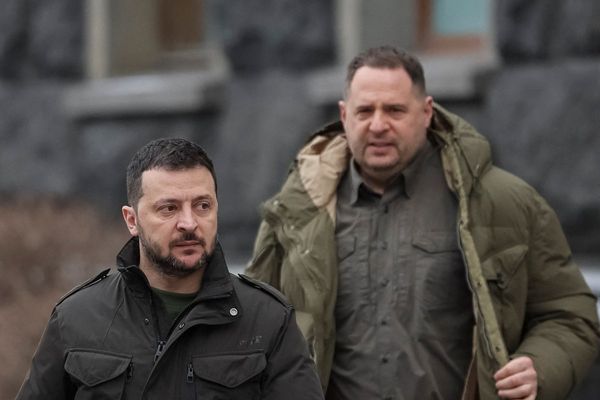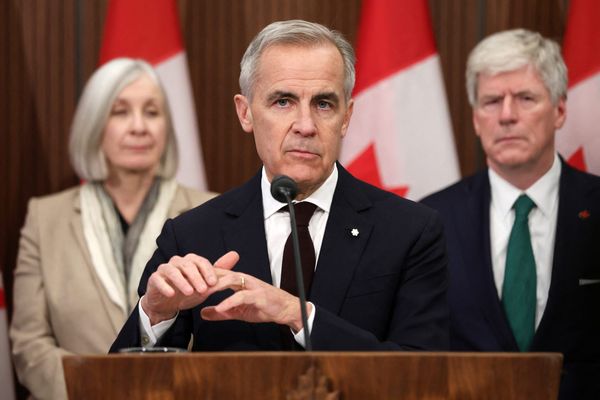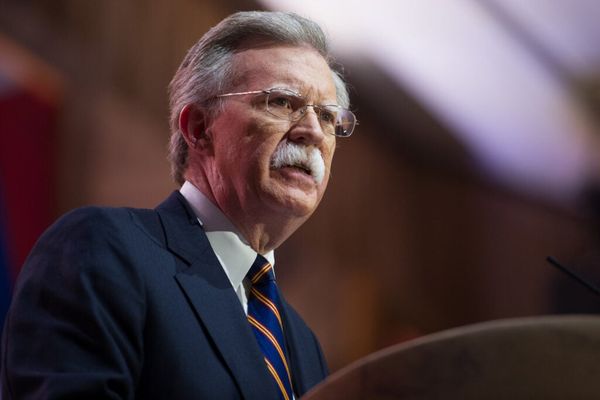
Driving through the parched farmlands in south-west Victoria, it is difficult to imagine that much of this coastal stretch was once a vision of untarnished natural beauty.
To assume this familiar rural landscape – the solitary naked tree protruding from a yellow field lined with wire fences – is its fixed setting is nothing short of deception.
“It was a bit like the Kakadu of the south,” says Shane Howard, a songwriter and researcher from Killarney, a small town on the south-west Victorian coast.
“It was a very fertile coast,” he adds, a tinge of sadness in his voice. “There was a time when people got lost between Port Fairy to Warrnambool, that’s how dense the forest was.”
The cultivated plots of land begin to recede as we edge closer to a rising slope of native bush. Tower Hill – a dormant volcano located between Warrnambool and Port Fairy – stands tall above raucous ocean waves and alone, the sole remnant of what was once a far-reaching forest.
Its story offers a glimpse into the nation’s past and its hopeful future. Stripped bare of forest immediately after colonisation, today flora once more drapes its cliffs courtesy of a successful seven-decade revegetation program. And the hill – the ancient heart of the region’s fertility – is nearing the next part of its healing. The land is close to being returned to traditional owners by way of native title, a journey that began with an environmental project in the 1960s and has resulted in a community reckoning with its past.
The lava that last flowed from Tower Hill about 35,000 years ago nourished the soil, producing an abundance of vegetation, wetlands and wildlife that sustained the area’s Indigenous clans for tens of thousands of years.
“It was a highly populated area, they say. Back in the day, 60,000 people or more lived through this region,” says Brett Clarke, a guide at Tower Hill.

Clarke belongs to the Kirrae Whurrung and the Peek Whurrong, the latter being the custodians of Tower Hill. “Peek means kelp and Whurrong means lip. They were ocean speakers.”
The specific clan who dwelled on this volcano were the Koroit Gunditj – Gunditj means belonging, Clarke says, and Koroit means volcano or fire.
Ascending the hill, the song of the wren offers respite from the roaring logging trucks on the nearby Princes Highway. The fragrance of the eucalypt cleanses the air. The canopies silence the raging winds of the Southern Ocean. It suddenly becomes evident why this place was a sanctuary for the nation’s First Peoples.
“The old people lived in harmony with mother Earth,” Clarke says.
Clarke leads us through the forest as we trace the marshes that now fill the volcano’s crater. He points to the water reed shooting out. “The old people made their baskets [out of the water reed].”

We cross the marsh, only to be halted by the sight of a koala devouring clumps of gum leaves and blissfully ignoring the bedazzled humans below. As we weave along the restored bush tracks, echoes of a more sinister past whisper through the leaves.
Early European colonisers were quick to tear down the trees of Tower Hill, using the timber for newly established settlements nearby.
However, the land clearing was not without opposition, even back then. James Dawson, a pioneer settler from Scotland who was appointed “a protector of Aborigines”, was “amazed and disgusted” upon visiting Tower Hill in 1891 “to find everything altered, the fine trees on the cones, and in the craters of the island, all gone excepting half a dozen or so”.
Dawson was said to be a friend of one Eugene von Guérard, a renowned 19th-century landscape artist who would, almost a century later, inspire a local reforestation drive. It is von Guérard’s famous painting of Tower Hill, which sought to capture its majestic original form prior to colonisation, that guided botanists on how to revegetate the landscape in the 1960s.
“The von Guerard oil painting was seen by some as a means of identifying species growing at Tower Hill in 1855,” Ranald Anderson, a former Tower Hill ranger, wrote in a 1995 paper for the Association of Societies for Growing Australian Plants.

“Back in the 60s, this place was completely denuded. Not a tree on it,” says 68-year-old Howard, who was a schoolboy when he was first bussed in to plant trees.
Schoolchildren and volunteers from surrounding communities would plant an estimated 300,000 trees between the 1960s and 1990s. According to Anderson, among the flora planted were blackwood, black wattle, swamp gum, manna gum and coastal tea trees.
In the past 25 years, community groups have “focused on restoring manna gums for koala habitat and planting locally indigenous trees and understory plants,” Dale Antonysen, district manager of Parks Victoria, says.
“We walk under a forest of our own making,” Howard says.
But there was another detail in von Guérard’s painting that, years later, prompted questions in the community.

“It wasn’t until I got older [that] I revisited von Guérard’s painting, and you see there’s Aboriginal people,” Howard says.
“As the years went by and we watched this country recover environmentally, and the trees grow … I knew that there was something darker that lay underneath it all.
“There was something missing from the landscape.”
***
The land’s richness might have also been its curse, for it was not long after the first European colonisers arrived on this continent that the prized volcanic lands of what is now the western district of Victoria were noticed.

“A land so inviting and still without inhabitants!” Major Thomas Mitchell, one of the most significant colonial explorers, noted in 1836 as he made his way from the Murray River to the coastal town of Portland.
“Colonisation was so brutal in south-west Victoria. Now that’s true everywhere, but it was particularly brutal in the western district,” Howard says.
Historical documentation of the violence suffered by Indigenous people in south-west Victoria remains an ongoing process. The Guardian’s Killing Times map of massacres in the frontier wars shows numerous sites in between the Otways and the South Australian border, but stories, passed down through generations in secret, are still coming to the surface.
“My grandfather’s grandfather was born to the west of here,” Clarke says. “He was walking with a large community group, they were invited to the house for a feed. He didn’t trust white people, he could see what was going on in the area. There was a lot of bloodshed. He said no to the invite and kept moving.”
But some from the community accepted the invitation, “and little did they know that they were about to be fed poisoned porridge,” Clarke says, pausing to reflect. “I’m here to tell you this story today because my pop’s grandfather refused to go in for that feed.”
Sharing these stories is “how we heal as a nation”, he says.
“There is a massacre story of this area, and some managed to escape.”
The wounds of genocide are rarely confined to history.

Aboriginal testimony is not the only source of the violent truth in this region. Some colonisers were quite transparent about the brutal methods of dispossession. Niel Black, a Scottish native who took part in the land grabs of the western district, wrote in his diary in 1839:
“The best way [to procure a run] is to go outside and take up a new run, provided the conscience of the party is sufficiently seared to enable him without remorse to slaughter natives right and left. It is universally and distinctly understood that the chances are very small indeed of a person taking up a new run being able to maintain possession of his place and property without having recourse to such means – sometimes by wholesale.”
Black would become a wealthy pastoralist using confiscated land in the western district and one of the new colony’s early prominent politicians. According to the Australian National University archives, he died in 1880, leaving an estate of £179,208 – the equivalent of roughly $50m today.
***
Nearly two centuries later, Victoria is walking a path toward truth-telling and treaty. And in this south-western corner of the state, which saw some of the most violent campaigns of dispossession, the truth-telling has already begun.
“It’s been a long journey from the 60s to the realisation in the broader community that you can’t have environmental restoration without cultural restoration,” Howard says. Cultural restoration, he says, requires confronting the region’s history, which will be “hard for whitefellas to hear”.
That restoration took a significant step last month when native title was announced for the Eastern Maar Aboriginal Corporation, covering a large swathe of country in south-west Victoria. Excluded, for the time being, is Tower Hill. The ancient volcano remains in negotiation between various Indigenous groups who claim connection to the hill, which only reinforces its historical significance.
“[Tower Hill] is central to our countryside, it’s central to a lot of our stories of creation of the area,” says Jeremy Clark, who is a Peek Whurrong and Tjap Whurrong man. He is also the new business manager of Barpa, an Indigenous construction company that recently won a contract from Parks Victoria to rehabilitate the visitor centre at Tower Hill.
“It’s been a source of living and growth for our people.”
Works on the visitor centre are expected to commence in late April or May, “subject to final approvals and on-ground conditions,” Antonysen of Parks Victoria says. “We’re delighted to be working on projects at Tower Hill in partnership with the Eastern Maar Aboriginal Corporation,” he adds.

Clark expects neighbouring Indigenous groups to agree to boundaries this year, paving the way for Tower Hill to be incorporated into the native title.
“It’s been a very, very long journey,” said Gabrielle Williams, Victorian minister for treaty and First Peoples, when announcing the native title in Warrnambool on 28 March, 2023. “I hope this [native title] acknowledges the dispossession, the violence and the pain that has brought us to this place … that renders this day necessary.”
Part of the healing is not only truth-telling, but restoring an Aboriginal voice in the land management and conservation efforts in areas like Tower Hill.
“We have lofty goals in terms of our approaches,” says Marcus Clarke, a Gunditjmara-Kirrae Whurrong man and the chief executive officer of the Eastern Maar Aboriginal Corporation. “We’re really keen to utilise language to inform what species should be present by flora and fauna to then build that system. A lot of the dreaming stories that we hold also inform what species should be present.”
The native title return has occurred against a political backdrop that has positioned Australia at a critical juncture in its history. With the upcoming referendum on the Indigenous voice to parliament and the environmental crisis dominating political conversations, Howard says Australia has an opportunity to truly define what it means to be a nation.
“We’re heading towards the starting line, I would say, of being a nation,” he says.
“What Tower Hill teaches us [is] that it’s not enough just to do environmental restoration. You’ve got to ask: what happened to the people who were here for 65,000 years beforehand?
“You can’t have environmental restoration without an Aboriginal voice at the table … This is what a voice looks like.”
A voice with intimate knowledge of the landscape, ready to enhance the land management of Tower Hill and other parks in the area for the benefit of all.
“Work with us,” Marcus Clarke says. “We’ve got something to offer. We’ve got to share country.”







